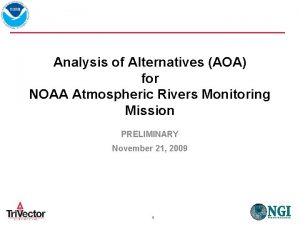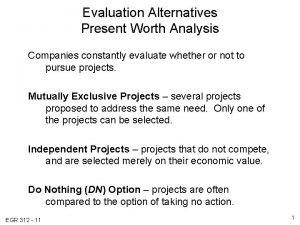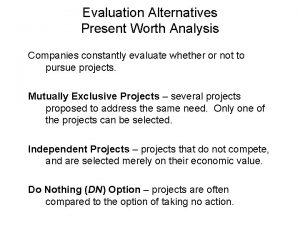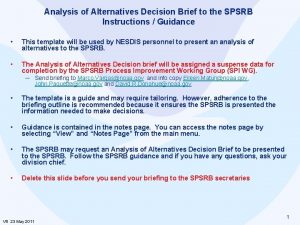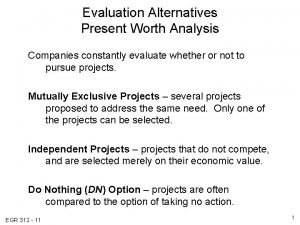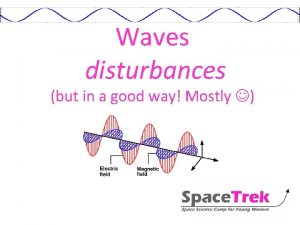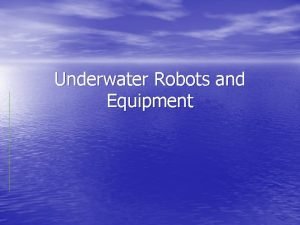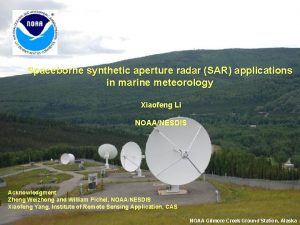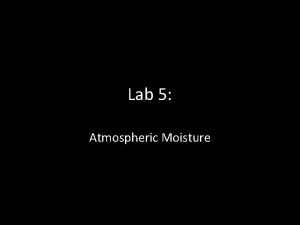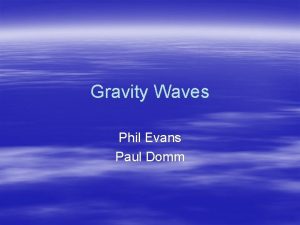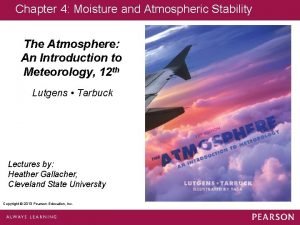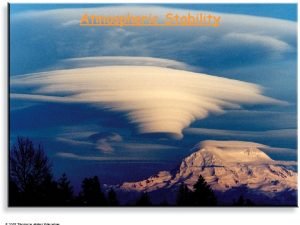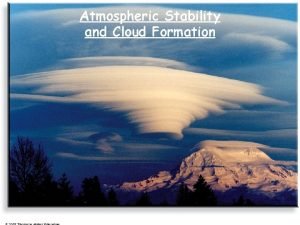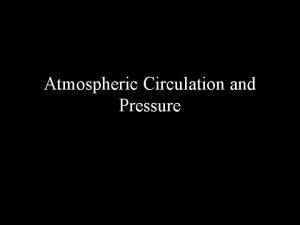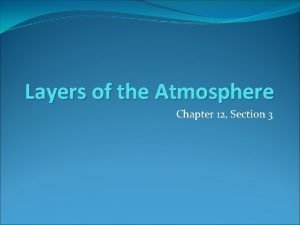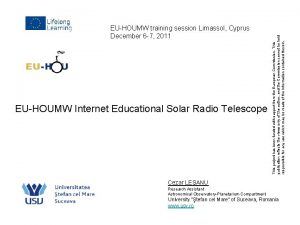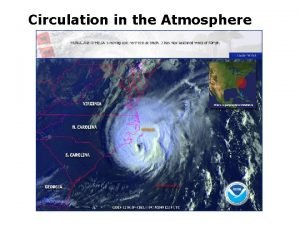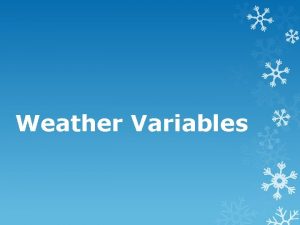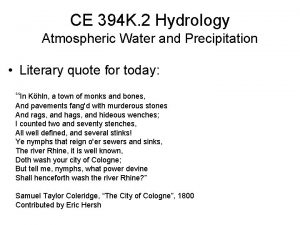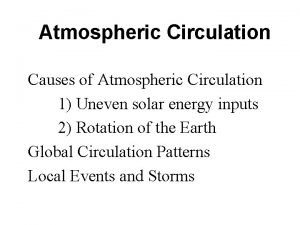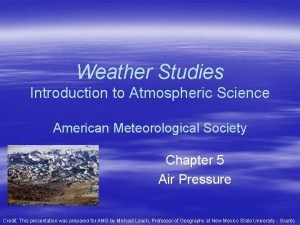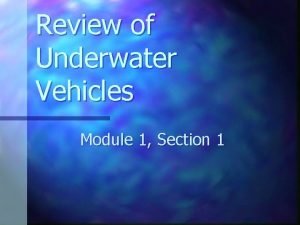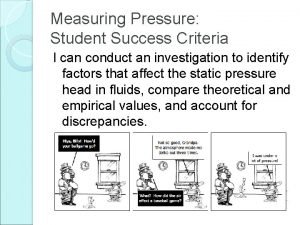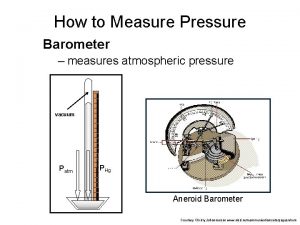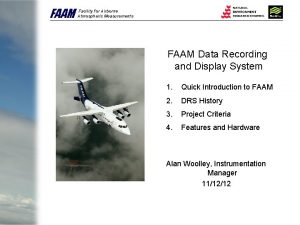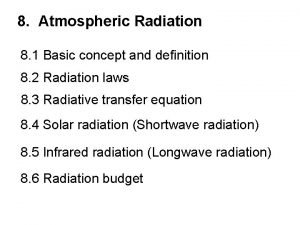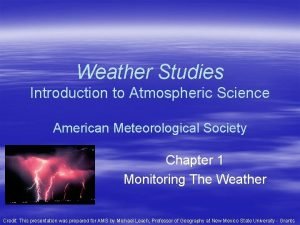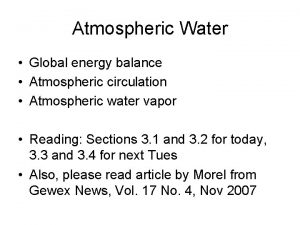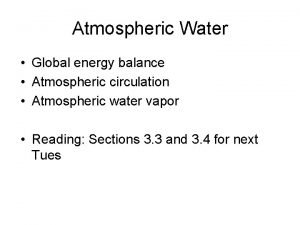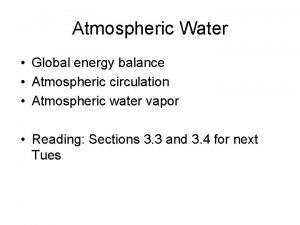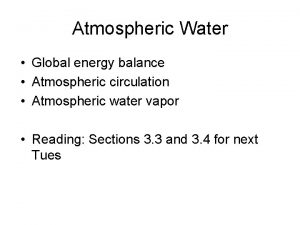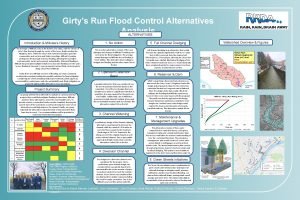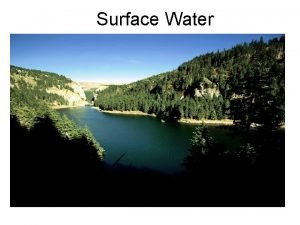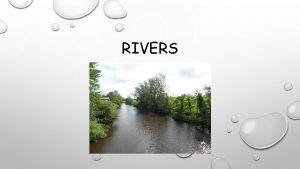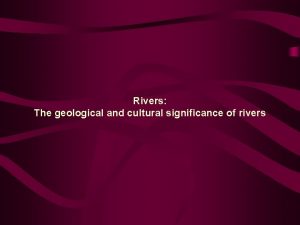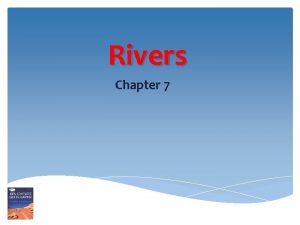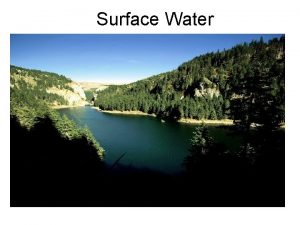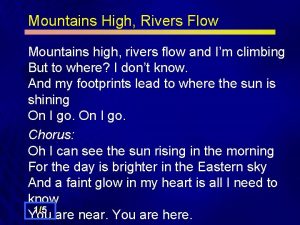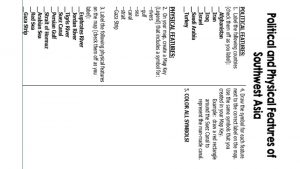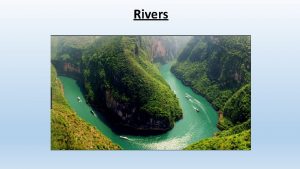Analysis of Alternatives AOA for NOAA Atmospheric Rivers












































- Slides: 44

Analysis of Alternatives (AOA) for NOAA Atmospheric Rivers Monitoring Mission PRELIMINARY November 21, 2009 1

Introduction u. The National Oceanic and Atmospheric Administration (NOAA) Unmanned Aircraft Systems (UAS) Program requires an Analysis of Alternatives for UAS platforms, with consideration of current NOAA assets available that perform science missions. u. The analyses are based upon mission requirements defined by the NOAA led Mission Science Teams. An analysis will be performed for each defined mission and the results of all individual mission analyses will be integrated to reach an overall recommendation for NOAA use of UAS. u. This analysis is focused on the Atmospheric Rivers Monitoring Mission. u. Key organizations participating or who provided data for the study include the NOAA UAS Program Director’s Office, NOAA Office of Marine and Aviation Operations (OMAO), NOAA Scientist, National Aeronautics and Space Administration (NASA) Dryden Global Hawk Program Office and the Army UAS Program Management Office. 2

Analysis Ground Rules Program baselined objectives and requirements for the atmospheric rivers monitoring mission will be utilized to drive the analysis. Alternatives to be considered for meeting the mission requirements include combinations of sensors/sensor packages; satellites, ships, manned aircraft, unmanned aircraft; data communications subsystems; and data processing subsystems. New technology development will be minimized, i. e. alternatives will utilize existing technology to the maximum extent possible. Selected alternatives will be analyzed for mission effectiveness, risk, life cycle cost, and schedule. 3

Analysis of Alternatives Approach Perform an Analysis of Alternatives (Ao. A) for the Atmospheric Rivers Monitoring Mission using the following steps: ü Identify mission objectives and requirements Develop alternatives for meeting mission objectives and satisfying requirements Analyze alternatives for mission effectiveness Analyze alternatives for risk Analyze alternatives for cost/schedule Provide comparison of alternatives and recommendations based on analysis results 4

Mission Objective: Atmospheric Rivers Monitoring This mission supports the NOAA Weather and Water mission goal. The legislative drivers for this mission are 15 U. S. C. 313 and 49 U. S. C. 1463 The mission objective is to significantly improve forecasts of precipitation and flooding resulting from winter storms along the west coast of the US and Hawaii by improving our understanding of atmospheric rivers of enhanced water vapor transport over the Pacific Ocean. This objective will be accomplished by: Acquiring, analyzing, and assimilating data measurement profiles within and surface data measurements beneath atmospheric rivers. The successful implementation of this mission is projected to improve lead-time, precipitation amount, and spatial resolution of the forecasts leading to ……. . (need a punch line here for benefits) 5

Atmospheric Rivers Monitoring Mission Requirements– Profile Measurements 6

Atmospheric Rivers Monitoring Mission Requirements– Surface Measurements 7

Mission Tasks 1. Identify and track the development of Atmospheric Rivers 2. Maneuver Observing Platform to Atmospheric Rivers areas of interest 3. Acquire, Analyze, and Assimilate profile measurements within atmospheric rivers 4. Acquire, Analyze, and Assimilate surface measurements beneath atmospheric rivers 8

Analysis of Alternatives Approach Perform an Analysis of Alternatives (Ao. A) for the Atmospheric Rivers Monitoring Mission using the following steps: Identify mission objectives and requirements üDevelop alternatives for meeting mission objectives and satisfying requirements Analyze alternatives for mission effectiveness Analyze alternatives for risk Analyze alternatives for cost/schedule Provide comparison of alternatives and recommendations based on analysis results 9

Assumptions New light weight GPS Dropsonde under development by NCAR for UAVs is available and will meet the atmospheric rivers monitoring profile data acquisition and resolution/accuracy requirements. Scripps developed sensor suite will meet the atmospheric rivers surface data acquisition resolution/ accuracy requirements. Observing platforms for all alternatives are equipped with SATCOM for transmission of acquired data. NOAA Earth System Research Laboratory (ESRL) and National Centers for Environmental Prediction (NCEP) will receive, process, and disseminate data from all alternatives. 10

Development of Alternatives Generic Mission Support System Alternative Mission Support Systems • Develop new satellite/sensors system • Use existing NOAA/USAF manned weather reconnaissance aircraft systems • Use High Altitude Long Endurance (HALE) Unmanned Aircraft Systems (UAS) with appropriate sensor suite, communications subsystem, and data processing subsystem. • Use Low Altitude Long Endurance (LALE) Unmanned Aircraft Systems (UAS) with appropriate sensor suite, communications subsystem, and data processing system 11

Development of Alternatives (Cont) The following Alternative was deemed not viable: Development of new Satellite/Sensor Systems. Not viable due to high cost and long lead time for development The following Alternatives were selected for Analysis: Alternative 1 – Existing Satellite Systems NOAA Geostationary Operational Environmental Satellite (GOES) System NOAA Polar Operational Environmental Satellite (POES) System Do. D Defense Meteorological Satellite Program (DMSP) Standard operations for GOESS, POESS, and DMSP coverage, data acquisition, transmission, processing and dissemination of data. Alternative 2 – Manned Aircraft Systems Existing NOAA/USAF Manned Aircraft Systems NOAA Gulfstream IV (1), WP-3 Orion (2), and USAF WC-130 J (10) aircraft Standard storm coverage operations for Gulfstream IV and 2 WP-3 aircraft deploying from Edwards Air Force Base (EAFB) or an airfield in Monterey. Gulfstream IV operating at 45, 000 ft nominal altitude and WP-3 s/WC-130 s operating at 30, 000 ft nominal altitude. All aircraft deploy dropsondes and use existing sensor suites Data transmission is via the same links as for hurricane coverage and data are sent to ESRL and NCEP for processing and dissemination. 12

Development of Alternatives (Cont) Alternative 3 – HALE UAS The HALE UAS consists of one Global Hawk (GH) Unmanned Aircraft Vehicle (UAV) and one control station. The GH UAV is outfitted with a GPS dropwindsonde system to obtain the profile measurement data. The UAS is based at Dryden Flight Research Center (DFRC). EAFB Restricted Airspace is used to fly the UAVs to operating altitude. Flight operations are initiated when the leading edge of the event is 3 days from the coast and each flight lasts approximately 24 hours. The GH is outfitted with SATCOM for transmission of the science data to ESRL and NCEP for processing and dissemination. Alternative 4 – Ship Based Low Altitude Long Endurance (LALE) Unmanned Aircraft System (UAS) Alternative 4 consists of two LALE UASs, each consisting of three unmanned aircraft vehicles (UAVs) and two control stations. Each UAV is outfitted with the sensor package developed by Scripps to acquire surface measurements beneath the atmospheric river. Each UAS (UAVs, mission control element, and launch and recovery element) is based on a NOAA ship. 13

Development of Alternatives (Cont) Alternative 4 – Ship Based LALE UAS (Cont) When the beginning of an atmospheric river event is detected, the ships deploy to an area on the edge of the projected river near the planned vertical profile transects. Flight operations are initiated when the atmospheric river is 3 days from the coast and continue until landfall as the ships move parallel to the atmospheric river following the profile transects movement toward the coast. The ships launch and recover LALE aircraft as required to provide the surface measurements beneath the vertical profile transects. Each aircraft is outfitted with SATCOM for real time transmission of the science data to ESRL and NCEP. Alternative 5 – Land Based LALE UAS Alternative 5 consists of one LALE UAS of three unmanned aircraft vehicles (UAVs) and two control stations. Each UAV is outfitted with the sensor package developed by Scripps to acquire surface measurements beneath the atmospheric river. The UAS (UAVs, mission control element, and launch and recovery element) is based at Vandenberg Air Force Base. Flight operations are initiated when the atmospheric river is in range of the aircraft and continue until landfall. Two aircraft are flying throughout the operations period. Each aircraft is outfitted with SATCOM for transmission of the science data to ESRL and NCEP. 14

Analysis of Alternatives Approach Perform an Analysis of Alternatives (Ao. A) for the Atmospheric Rivers Monitoring Mission using the following steps: Identify mission objectives and requirements Develop alternatives for meeting mission objectives and satisfying requirements üAnalyze alternatives for mission effectiveness Analyze alternatives for risk Analyze alternatives for cost/schedule Provide comparison of alternatives and recommendations based on analysis results 15

Analysis of Mission Effectiveness Perform an Analysis of Mission Effectiveness for each alternative in accordance with the following steps: For each mission task, establish measures of effectiveness in accomplishing the task. For each alternative, establish performance measures. Evaluate the performance of each alternative against the measures of effectiveness for each mission task. Compare effectiveness of each alternative in performing the mission tasks. 16

Measures of Effectiveness (Mo. E) Mission Task 1 - Identify and track the development of atmospheric rivers Mo. E: a. b. Continuous coverage of atmospheric river Periodic coverage of atmospheric river Mission Task 2 - Maneuver observing platform to atmospheric river areas of interest Mo. E: a. Maneuverability to observing altitude and range Mission Task 3 - Acquire, analyze, and assimilate profile measurements within atmospheric rivers Mo. E: a. b. c. d. e. f. Acquire specified profile data measurements Achieve desired altitude of 0 to 40, 000 ft Achieve desired transect range of 10, 000 nm Refresh data once per day when 2 -3 days from landfall; every 1 -3 hours during 24 hours leading up to landfall On-site in operational areas within 2 days of call up Provide data access within 1 hour Mission Task 4 - Acquire, analyze, and assimilate surface measurements beneath atmospheric rivers Mo. E: � � � Acquire specified surface data measurements Achieve desired altitude of 0 to 300 ft Achieve desired transects of 550 nm corresponding to profile observations Refresh data once to twice per day as events approach landfall up to 3 days out On-site in Operational areas within 24 hours of call up Provide data access within 3 hours 17

Performance Measures for Satellite Systems NOAA Geostationary Operational Environmental Satellite System The system uses two satellites in geosynchronous orbits 19340 nmi above the earth, one over the east coast of the US and one over the west coast providing overlapping continuous coverage of the US, Atlantic to the west coast of Africa, and eastern Pacific to 140 degrees west longitude Satellite instrumentation consists of an imager and sounder The imager provides 1 channel of visible and 4 channels of infrared images with a scan rate for full earth disc of less than or equal to 26 minutes The sounder provides temperature and moisture profiles of the atmosphere Data is continuously transmitted to ground terminals for processing and rebroadcast to primary weather service offices in the US and around the world and to the global research community NOAA Polar Operational Environmental Satellite System The system uses two satellites in sun synchronous, nearly polar orbits 470 nmi above the earth. Each satellite provides global coverage every 14. 1 hours. Satellite instrumentation includes an Advanced Very High Resolution Radiometer (AVHRR), a High Resolution Infrared Radiation Sounder (HIRS), Advanced Microwave Sounding Unit-A (AMSU-A) and Advanced Microwave Sounding Unit-B (AMSU-B) AVHRR provides visible and infrared images of the Earth and its atmosphere HIRS provides data to calculate vertical temperature profiles from the Earth’s surface to an altitude of approximately 22 nmi. AMSU-A measures global atmospheric temperature profiles and information on atmospheric water AMSU-B unit provides global data on humidity profiles Satellite data are transmitted to NOAA Command Data Acquisition (CDA) stations for processing and distribution to users 18

Performance Measures for Satellite Systems (Cont) Do. D Defense Meteorological Satellite Program (DMSP) The system is currently using data from four satellites (3 day/night, 1 dawn/dusk) in circular, sun synchronous, nearly polar orbits 450 nmi above the earth with an orbital period of 101 minutes. Each satellite provides global coverage twice a day. Satellite instrumentation includes an Operational Linescan System (OLS); Special Sensor Microwave Imager (SSM/I); Special Sensor Microwave Imager Sounder (SSMIS); Special Sensor Microwave Water Vapor Sounder (SSM/T-2); Atmospheric Temperature profiler (SSM/T); Precipitating Electron and Ion Spectrometer (SSJ/4); Ion Scintillation Monitor (SSI/ES); and Magnetometer (SSM). OLS provides visible and infrared images used to monitor the global distribution of clouds and cloud top temperatures. SSM/I and SSMIS data are used to derive ocean surface wind, area covered by ice, ice edge, precipitation, cloud liquid water, integrated water vapor, soil moisture, land surface temperature, snow cover, and sea surface temperature. SSM/T provides atmospheric temperature profiles. SSM/T-2 provides water vapor concentrations. The space environment sensors (SSJ/4, SSI/ES, and SSM) record along-track plasma densities, velocities, composition, and drift. Satellite data are transmitted to command readout stations and forwarded to the Air Force Weather Agency (AFWA) for processing and distribution to users and the National Geophysical Data Center’s Solar Terrestrial Physics Division Earth Observation Group (NGDC/STP/EOG) for archiving 19

Performance Measures for NOAA/USAF Manned Aircraft Systems 20

Performance Measures for HALE/LALE UAS 21

Effectiveness Determination The performance measures for each alternative are compared to the measures of effectiveness for each mission task. For example: MT 3 -Acquire, analyze, and assimilate profile measurements within atmospheric rivers Mo. E b - Achieve desired Altitude of 0 to 40, 000 ft Altitudes of 19, 340 nm and 470 nm for the GOESS and POESS, respectively, are fixed and cannot meet the requirements = 0% effective Gulfstream IV altitude ceiling = 45, 000 ft = 100% effective WP-3 altitude ceiling = 30, 000 ft = 75% effective WC-130 J altitude ceiling = 30, 000 = 75% HALE altitude ceiling = 65, 000 ft = 100% effective Mo. E c - Achieve desired transect range of up to 10, 000 nm GOESS provides near continuous coverage of area of interest = 100% effective POESS/DMSP provides coverage of area of interest every 7 hours = 100% effective Gulfstream IV range = 4, 000 nm = 40% effective WP-3 range = 3, 000 nm = 30% effective WC-130 J range = 3, 500 nm = 35% effective HALE range = 12, 000 nm = 100% effective 22

Effectiveness Analysis Results 23

Effectiveness Analysis Summary Alternative 1 – GOESS, POESS, and DMSP Satellite microwave radiometers provide an estimate of the total amount of water vapor in the atmosphere along the path from the satellite to the surface which provides a good picture of the location of the atmospheric river and some suggestion of its strength. However, they fail to give a measure of the actual water vapor transport. Additionally, satellite infrared and microwave sounders provide some information on water vapor profiles but over broader layers than what is required and profiles of wind speed is missing entirely. High resolution profiles of the water vapor content and wind speed are required to compute the actual water vapor transport. These profiles are obtainable through dropsonde measurements. Alternative 2 – NOAA/USAF Manned Aircraft The Gulfstream IV can provide profile data, however: Aircraft range limits data coverage to less than 50% of that required during the life of the atmospheric river. Aircraft cannot meet the data requirements for the surface measurements beneath the atmospheric rivers. WP-3 Orion/WC-130 J aircraft can provide mid altitude profile data, however: Aircraft operating altitude and range limit data coverage to less than 50% of that required during the life of the atmospheric river. Aircraft cannot meet the data requirements for the surface measurements. 24

Effectiveness Analysis Summary (Cont) Alternative 3 – High Altitude Long Endurance (HALE) Unmanned Aircraft System (UAS) A HALE UAS is required to meet the vertical profile data altitude and range requirements over the life of the atmospheric river The Global Hawk (GH) is the only currently available HALE UAS with the required range and altitude capability for complete coverage of the life cycle of an atmospheric river event from three days out. A minimum fleet of one aircraft outfitted with the appropriate GPS dropsonde system can provide the vertical profile data with the required refresh rate during the life of the atmospheric river event. The GH cannot meet the data requirements for the surface measurements beneath the atmospheric river. There appear to be three options available for NOAA to acquire a Global Hawk for support of the atmospheric rivers mission: NOAA could lease flight time on one of the NASA GH The USAF appears ready to excess their fleet of 7 GH BLK 10 aircraft which NOAA could take ownership of and operate for the Atmospheric Rivers mission A new GH BLK 20 UAS could be purchased from Northrop Grumman Mission effectiveness is basically the same for the GH BLK 10 and GH BLK 20. However, there are significant cost and schedule differences which are discussed later in this presentation. 25

Effectiveness Analysis Summary (Cont) 26

Effectiveness Analysis Summary (Cont) 27

Effectiveness Analysis Summary (Cont) Alternative 4 – Ship Based Low Altitude Long Endurance (LALE) Unmanned Aircraft System (UAS) Alternative 4 provides two LALE UAS, each consisting of three aircraft and two control stations, deployed on ships to provide the necessary surface measurement data coverage. Ship based LALE UAS are able to provide coverage for the life of the event from 3 days out. The major constraint to the LALE UAS at the present time is the operational access to the necessary airspace to perform the mission. Alternative 5 – Land Based Low Altitude Long Endurance (LALE) Unmanned Aircraft System (UAS) Alternative 5 provides 1 LALE UAS consisting of three aircraft and two control stations, based at Vandenberg AFB to provide the necessary surface measurement data coverage. Due to LALE range limitations, land based LALE UAS con provide coverage only during the last 24 ours prior to landfall. The major constraint to the LALE UAS at the present time is the operational access to the necessary airspace to perform the mission. 28

Analysis of Alternatives Approach Perform an Analysis of Alternatives (Ao. A) for the Atmospheric Rivers Monitoring Mission using the following steps: Identify mission objectives and requirements Develop alternatives for meeting mission objectives and satisfying requirements Analyze alternatives for mission effectiveness üAnalyze alternatives for risk Analyze alternatives for cost/schedule Provide comparison of alternatives and recommendations based on analysis results 29

UAS Program Risk Management Process Risk Analysis Risk Management 30

HALE UAS Risk Analysis GH BLK 10 Technical, T 1. 2. GPS dropsonde system development for GH is unsuccessful, P=1, I=5 GH can not operate in environment above an atmospheric river, P=1, I=5 Programmatic, P 1. 2. 3. Increased cost for obsolete parts to maintain aircraft, P=3, I=3 Schedule delay due to late completion of GPS dropsonde system. P=1, I=5 Schedule delay due to flight worthiness certification following modifications to aircraft, P=3, I =3 Operational, O 1. Extended aircraft downtime due to long lead obsolete/replacement parts, P=3, I=3 31

HALE UAS Risk Analysis GH BLK 20 Technical, T 1. 2. GPS dropsonde system development for GH is unsuccessful, P=1, I=5 GH can not operate in environment above a TC, P=1, I=5 Programmatic, P 1. 2. Schedule delay due to late completion of GPS dropsonde system. P=1, I=5 Schedule delay due to flight worthiness certification following modifications to aircraft, P=3, I =3 Operational, O 1. Delayed operational capability due to long lead-time for aircraft delivery, P=4, I=3 32

LALE UAS Risk Analys. Is Technical 1. Sensor development for surface measurements may be unsuccessful. P=1. I=5 Programmatic 1. Cost and schedule risks due to sensor development, P=2, I=4 Operational 1. Inability to gain access to required airspace, P=3, I=5 33

Analysis of Alternatives Approach Perform an Analysis of Alternatives (Ao. A) for the Atmospheric Rivers Monitoring Mission using the following steps: Identify mission objectives and requirements Develop alternatives for meeting mission objectives and satisfying requirements Analyze alternatives for mission effectiveness Analyze alternatives for risk üAnalyze alternatives for cost/schedule Provide comparison of alternatives and recommendations based on analysis results 34

Cost Analysis – Global Hawk HALE u Lease of NASA Global Hawks for Atmospheric Rivers Monitoring • NASA lease rate = $2500/flight hour • Each event requires 96 flight hours • For 18 events/season, cost = $4, 320, 000/season u. Transfer of USAF GH Block 10 Global Hawks 35

Cost Analysis – Global Hawk HALE (Cont) u Purchase of new GH Block 20 Global Hawk 36

Cost Analysis – LALE u. Purchase of two new LALE (Shadow 200 class) UAS 37

Cost Analysis – LALE (Cont) u. Purchase of one new LALE (Shadow 200 class) UAS 38

HALE/LALE UAS Schedule Assessments HALE UAS Based on current plans for NASA Global Hawks, it is estimated that one GH will be available for lease in 2012. Due to delays in the GH BLK 20/30/40 delivery, the USAF is reportedly delaying excessing the BLK 10 UAS to 2012. Assuming NOAA partners with NASA and leverages their experience in standing up a GH system, it is estimated that NOAA could have a HALE UAS consisting of 1 GH BLK 10 vehicle and 1 Control Station ready for initial operations in 2013. Based on procurement processes and new order lead times, it is estimated that a UAS with 1 new GH BLK 20 vehicle and 1 control station would be available in 2014. LALE UAS Based on discussions with the Army relative to their experience fielding the Shadow UAS, it is estimated that the LALE UAS acquisition and preparations for initial operations would take approximately one year after contract award. 39

Analysis of Alternatives Approach Perform an Analysis of Alternatives (Ao. A) for the Atmospheric Rivers Monitoring Mission using the following steps: Identify mission objectives and requirements Develop alternatives for meeting mission objectives and satisfying requirements Analyze alternatives for mission effectiveness Analyze alternatives for risk • Analyze alternatives for cost/schedule üProvide comparison of alternatives and recommendations based on analysis results 40

Comparison of Alternatives 41

Comparison of Alternatives Summary Mission Effectiveness A combination of HALE and LALE UAS can provide the data coverage required to monitor atmospheric river events and improve forecasts of precipitation and flooding resulting from winter storms along the west coast of the US. Risk The GH BLK 10 and BLK 20 have moderate risk factors associated with sensor package development and the ability to operate in the environment above an atmospheric river. The GH BLK 10 has further moderate risk associated with maintaining flight worthiness of the obsolete aircraft The LALE UAS has a high risk of obtaining access to the airspace required to perform its mission. 42

Comparison of Alternatives Summary (Cont) Cost/Schedule Lease of a NASA Global Hawk provides the lowest cost solution and earliest availability of a HALE. Acquisition costs for the GH BLK 10 UAS transferred from the USAF ($13 M) are significantly lower than a new GH BLK 20 UAS ($38 M). The estimate of 12 months to reach Initial Operational Capability (IOC) for the GH BLK 10 UAS is significantly better than the estimate of 24 – 36 months for the GH BLK 20 UAS. 43

Recommendations Because of significant economic and life saving benefits available from projected improvements in forecasts of west coast winter storm precipitation and flooding, NOAA should proceed to acquire both HALE and LALE UAS for atmospheric rivers data gathering. Acquisition of the global Hawk BLK 10 UAS from the USAF appears to have significant cost and schedule advantages over procurement of a new BLK 20 UAS. However, these advantages may be significantly offset by the disadvantages of maintaining the flight worthiness of an obsolete aircraft. More data from the USAF on the BLK 10 system is required for analysis before a final decision is made. There a number of available LAL UAS that can provide the required range and altitude. However, more detailed studies of alternate LALE UASs and sensors for the surface measurements mission are required prior to a final selection. Additionally, NOAA must continue to support efforts to obtain airspace access for UAS which is required to implement the LALE UAS CONOPS. 44
 Aoa analysis of alternatives
Aoa analysis of alternatives Why are some rivers in texas called “wrong way” rivers?
Why are some rivers in texas called “wrong way” rivers? Present worth analysis of different-life alternatives
Present worth analysis of different-life alternatives Present worth
Present worth Analysis of alternatives template
Analysis of alternatives template Present worth analysis of different-life alternatives
Present worth analysis of different-life alternatives Atmospheric opacity
Atmospheric opacity Atmospheric perspective watercolor
Atmospheric perspective watercolor Atmospheric diving system
Atmospheric diving system Atmospheric gravity waves
Atmospheric gravity waves Penn state department of meteorology
Penn state department of meteorology Lab 5 atmospheric moisture
Lab 5 atmospheric moisture Pressure at different altitudes
Pressure at different altitudes Forceparcel
Forceparcel Single cell model of atmospheric circulation
Single cell model of atmospheric circulation Atmospheric stability
Atmospheric stability Define unstable equilibrium
Define unstable equilibrium Conditionally unstable atmosphere
Conditionally unstable atmosphere Single cell model of atmospheric circulation
Single cell model of atmospheric circulation Atmospheric heaven
Atmospheric heaven The four main layers of the atmosphere
The four main layers of the atmosphere Atmospheric opacity
Atmospheric opacity Atmospheric circulation
Atmospheric circulation Atmospheric distortion correction
Atmospheric distortion correction What are weather variables
What are weather variables Layers of the atmosphere definitions
Layers of the atmosphere definitions Atmospheric convection
Atmospheric convection A first course in atmospheric thermodynamics solutions
A first course in atmospheric thermodynamics solutions Atmospheric convection
Atmospheric convection Atmospheric convection
Atmospheric convection Atmospheric convection
Atmospheric convection Weather studies introduction to atmospheric science
Weather studies introduction to atmospheric science Dr jack soaring
Dr jack soaring Atmospheric diving suit
Atmospheric diving suit Atmospheric chemistry lecture notes
Atmospheric chemistry lecture notes Pressure head definition
Pressure head definition What measures atmospheric pressure
What measures atmospheric pressure Facility for airborne atmospheric measurements
Facility for airborne atmospheric measurements Atmospheric refraction
Atmospheric refraction Atmospheric reaction
Atmospheric reaction Atmospheric
Atmospheric Tiefdruckgebiet
Tiefdruckgebiet In which of the following practices
In which of the following practices Weather studies introduction to atmospheric science
Weather studies introduction to atmospheric science S shape curve
S shape curve
